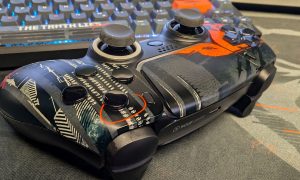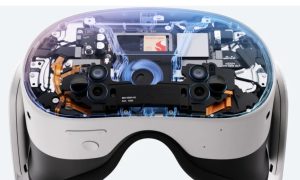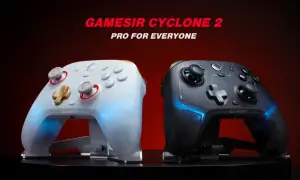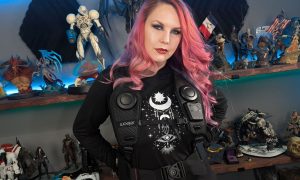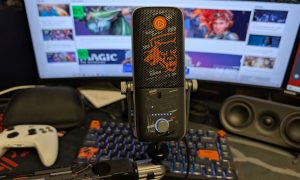 It seems like Tecmo likes to release Dead or Alive fighting games shortly after the release of a system. You have Dead or Alive 2 on the Dreamcast, Dead or Alive Hardcore on the PS2, Dead or Alive 3 on the Xbox, and Dead or Alive 4 on the Xbox 360. While Dead or Alive Paradise was the first DOA game to be released on a portable system, Tecmo Koei has decided to give the 3DS the first true DOA portable fighting game with Dead or Alive Dimensions.
It seems like Tecmo likes to release Dead or Alive fighting games shortly after the release of a system. You have Dead or Alive 2 on the Dreamcast, Dead or Alive Hardcore on the PS2, Dead or Alive 3 on the Xbox, and Dead or Alive 4 on the Xbox 360. While Dead or Alive Paradise was the first DOA game to be released on a portable system, Tecmo Koei has decided to give the 3DS the first true DOA portable fighting game with Dead or Alive Dimensions.
Dimensions has several modes, but the first mode one should play is the Chronicle mode. This mode goes through the entire Dead or Alive storyline. You might not have known that the series had a storyline other than two people fighting in a tournament, but you will learn about a lot of the characters and the rivalries between them. There’s also a few, “Huh?” moments with some of the characters, but let’s face it, fighting games really don’t need much of a story. The story is told through cutscenes, some of which are long. They are probably too long for a portable game, but at least you can skip through them if you like. The cutscenes can also be a bit silly as well, but they do show more detailed information inside the bottom screen when new relevant information is revealed in the cutscenes. Chronicle mode also goes through the control system for the game. This is great for those who are new to the control system, and also a good refresher for those of us who have played the other games but haven’t played in a while. It’s also a great way to unlock new characters to play and costumes to use on the characters.
If you don’t want to go through the entire DOA saga, or you don’t want to watch all of those cutscenes, then there are plenty of other modes to keep you busy. The Arcade mode is the typical mode where you fight through eight random fighters and try to beat them in the quickest time. Survival mode has you go up against opponent after opponent until you die. Tag Challenge is a two-on-one match where you and a computer partner go up against an AI opponent. The free play lets you select a stage, the character you want to play as, and the opponent you want to face. The Training mode lets you practice moves against the computer. Local play lets you play against another person locally as long as that person has a copy of Dimensions as well, while Internet play lets you do the same online. Throwdown is unique in that it lets you play against fighters you have come across in StreetPass. You don’t fight against the actual people, just a representative AI of the player’s tendencies.
Tecmo Koei did what they could to take advantage of the capabilities of the 3DS. Even the “Now Loading” lettering has depth to it. The fighters pop out in the foreground. The backgrounds are detailed, but they always take a back seat to the fighting. The “K.O.” when the match is over pokes out at you. Before you get into the menus, you can also tilt the 3DS which will change the perspective of the stage shown in the top screen. It’s not a huge feature, but it is a nice touch to the game.

The twenty-five characters make up the diverse cast which includes Ninjas, wrestlers, martial artists, and drunks. Some are faster with long combos but less powerful attacks, while others focus on heavy attacks but are slow with their movements. While some characters are similar to each other, it will be easy to find one whose fighting style will match your style of play. The campaign will also help you to figure out the strengths and weaknesses of the characters by playing against them.
All of the characters look great. While they don’t look as good as the models in the Xbox 360 DOA4, they are about up to par with the DOA3 characters from the original Xbox. One thing that some people may appreciate about the female characters is that the breast bounce physics seem to be toned down from some of the previous games. While some of the outfits are as outrageous as before, they appear tame without perpetual unrealistic bounce effect going on.
The voices of the characters are going to be familiar to anyone who has played the previous DOA games. It truly is amazing how many voices they have packed within the game cartridge, especially since voices are used throughout the cutscenes instead of just subtitles.
The control system of the DOA games is unique. While it has the standard punch and kick buttons, it also has a throw button and a guard button. The throw button is used for throwing your opponent, while the guard button can be used to block attacks. Hitting the guard button at the appropriate time performs a hold move that counters an attack and causes a lot of damage to your opponent. The throw and guard buttons are vital to your success in the ring, so learning the timing of these two moves is incredibly important.
Previous DOA games have always been button-masher friendly, and that is true of Dimensions as well. A lot of moves just require different presses of the punch and kick buttons. The use of the throw and guard buttons does take getting used to, and some of the characters can perform counter after counter with ease. With time and practice, these buttons can become life savers. You can also perform high, mid, and low attacks depending on the direction of the controls. Your stance also determines if you can block an attack. While it can be easy to try to attack constantly, blocking attacks can be just as vital to success.

During the fight you can see a move list in the bottom screen. The list provided gives you the button presses to perform the moves, and you can also touch a move in the list to perform it. It also changes the move list when you are on the ground or your position changes. You can also touch one of the moves on the screen and your character will perform it. While this can be nice to try out a move occasionally, I can’t imagine playing the game by moving your character with the left hand and using the stylus in the right hand to perform attacks.
Like most fighting games, Dimensions usually consists of a best two-out-of-three round, although some matches in the campaign only require one win. Dimensions also features multi-level stages, where extra damage can be caused by forcing the opponent from the current level to the level below. While these aren’t as unique as they once were, they do add a bit of variety to each stage and keep you on your toes when you get too close to a ledge in the 3D arenas. You don’t want to be the one taking a tumble down the stage.
Dead or Alive Dimensions does a great job at creating a true Dead or Alive experience on a portable console. While the Chronicle mode can get a little crazy at times, the features of all the other modes make up for it. It also utilizes the StreetPass function and the built-in gyroscope, truly utilizing the abilities of the 3DS. If you thought you wanted a fighter for the 3DS but weren’t interested in Super Street Fighter IV: 3D Edition because of the more complex controls or you already have it for a home console, you might want to take a look at Dead or Alive Dimensions.
While not working as a Database Administrator, Keith Schleicher has been associated with Gaming Trend since 2003. While his love of video games started with the Telestar Alpha (a pong console with four different games), he trule started playing video games when he received the ill-fated TI-99/4A. While the Speech Synthesizer seemed to be the height of gaming, eventually a 286 AT computer running at 8/12 Hz and a CGA monitor would be his outlet for a while. Eventually he’d graduate to 386, 486, Pentium, and Athlon systems, building some of those systems while doing some hardware reviews and attending Comdex. With the release of the Dreamcast that started his conversion to the console world. Since then he has acquired an NES, SNES, PS2, PS3, PSP, GBA-SP, DS, Xbox, Xbox 360, Xbox One S, Gamecube, Wii, Switch, and Oculus Quest 2. While not playing video games he enjoys bowling, reading, playing board games, listening to music, and watching movies and TV. He originally hails from Wisconsin but is now living in Michigan with his wife and sons.

See below for our list of partners and affiliates:











